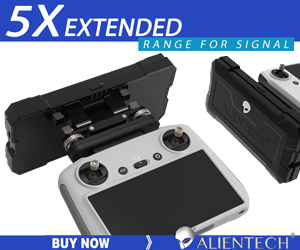The cost of FF lenses is to a large degree result of the size of glass in those lenses and other technologies such as optical zoom, image stabilization, weather sealing, AF, CA correction, distortion correction etc etc. These drone lenses are tiny in comparison and relatively simple. Most of their optical imperfections are corrected digitally via lens profiles. But the results are, perhaps surprisingly, pretty good after all the modern computational trickery is appliedCan a cheap *** lense even take quality photos?
Look at the cost of good full frame lenses. These drones must be cheap as **** with no quality at all on the glass
You are using an out of date browser. It may not display this or other websites correctly.
You should upgrade or use an alternative browser.
You should upgrade or use an alternative browser.
Air 3S photo quality is... disappointing
- Thread starter GroovyGeek
- Start date
- Status
- Not open for further replies.
All true I'd say, but QA seems poor considering the price of the whole drone. A lot of these cheap lenses seem to be de-centred. Only the fussy ones return them, so they get away with it.The cost of FF lenses is to a large degree result of the size of glass in those lenses and other technologies such as optical zoom, image stabilization, AF, CA correction, distortion correction etc etc. These drone lenses are tiny in comparison and relatively simple. Most of their optical imperfections are corrected digitally via lens profiles. But the results are, perhaps surprisingly, pretty good after all the modern computational trickery is applied
Concidering that these things fly themselves and some think they take quality images and video is realy a bargain in my mind at 1500 to even 3000 pricepoint.
Mine gets here tommorrow so ill see what i think compared to my other photo stuff. Im not likly to be dissapointed from what im seeing on the interweb.
It flys and takes photo and vid for 1500 bucks freaking amazing
Mine gets here tommorrow so ill see what i think compared to my other photo stuff. Im not likly to be dissapointed from what im seeing on the interweb.
It flys and takes photo and vid for 1500 bucks freaking amazing
There's no R&D. They avoid spending on more costly sensors like stacked CMOS and other components.I get that but you are talking about marketing of gadgets with QB sensors already in them. I am wondering what is pushing the R&D of the QB sensor technology in the first place?
But they have to give people a reason to buy or upgrade to the newest drones so 50 or 100 Mp is what's meant to stand out in a spec sheet.
Another big spec is flight time. The rumored battery capacity for the Mavic 4 Pro could mean flight times approaching an hour (of course that's just a spec, the actual flight time is much less than the stated flight time).
I would happy trade flight time for better camera and optics. Hell why not try a modest 3 or 4 to 1 optical zoom, instead of stuffing 2 or 3 cameras? Maybe we a good optical zoom means heavier aircraft, maybe even bigger, which would also mean lower flight time.
That's fine, I'd be okay with 25-30 minutes actual flight time, compared to what DJI claims is the flight time for the Air 3S or the Mavic 4 Pro.
But I suspect it's cheaper to put in 2 or 3 camera sensors, with 1 or 2 of them being smaller than 1-inch and touting longer flight times.
That probably sells better, even though I really wonder if people are getting 40-45 minutes flight time and using all of that extra time.
There lies to a large degree the answer to your own questionAll true I'd say, but QA seems poor considering the price of the whole drone. A lot of these cheap lenses seem to be de-centred. Only the fussy ones return them, so they get away with it.
Last edited:
A decent quality motorizes optical zoom for m43 sensor camera would significantly contribute to price and weight of the drone. If it happens one day, I do not think it will be cheap or on a lightweight platform. DJI does not even have an optical zoom for their flagship Inspire3.There's no R&D. They avoid spending on more costly sensors like stacked CMOS and other components.
But they have to give people a reason to buy or upgrade to the newest drones so 50 or 100 Mp is what's meant to stand out in a spec sheet.
Another big spec is flight time. The rumored battery capacity for the Mavic 4 Pro could mean flight times approaching an hour (of course that's just a spec, the actual flight time is much less than the stated flight time).
I would happy trade flight time for better camera and optics. Hell why not try a modest 3 or 4 to 1 optical zoom, instead of stuffing 2 or 3 cameras? Maybe we a good optical zoom means heavier aircraft, maybe even bigger, which would also mean lower flight time.
That's fine, I'd be okay with 25-30 minutes actual flight time, compared to what DJI claims is the flight time for the Air 3S or the Mavic 4 Pro.
But I suspect it's cheaper to put in 2 or 3 camera sensors, with 1 or 2 of them being smaller than 1-inch and touting longer flight times.
That probably sells better, even though I really wonder if people are getting 40-45 minutes flight time and using all of that extra time.
Last edited:
They had it briefly on the Mavic 2 Zoom. I think most people opted for the 2 Pro because of the 1-inch sensor, which was a big deal at the time.
Yah, that was 2x zoom over tiny 6.17x4.55mm (1/2.3) size sensor and it was not very bright zoom either. Not sure anyone would be happy with that IQ today. We can always dream...They had it briefly on the Mavic 2 Zoom. I think most people opted for the 2 Pro because of the 1-inch sensor, which was a big deal at the time.
That’s the question though, did they give up on that design, optical zoom, in favor of 2 or 3 cameras because of cost and image quality reasons? Certainly it’s easier to put in 2 or 3 cameras instead of developing a bespoke zoom which would be motorized and still be light enough?Yah, that was 2x zoom over tiny 6.17x4.55mm (1/2.3) size sensor and it was not very bright zoom either. Not sure anyone would be happy with that IQ today. We can always dream...
Or did they prioritize other design goals, like maximizing flight time, so they couldn’t have a big optical zoom assembly with maybe something exotic like foldable lenses.
I remember some compact cameras from 15-20 years ago, like cameras about as thick as a deck of cards but it had a 3 to 1 zoom which was motorized:
ryguy80
Well-Known Member
I agree the optics aren't there yet on drones for the price. You can get close to a nice full-frame camera set up for what people are paying for the Mavic Pro drone models.These doesn’t seem to be much innovation in camera sensors in general and especially at smaller sensor sizes, since phones are taking away camera sales.
In one inch and Micro 4/3 sensors, resolution still tops out at 20 Mp. Where DJI could have spent more on sensors would have been BSI or even more costly stacked 1-inch or Micro 4/3 sensors.
So drone cameras are still a couple generations behind some niche compact cameras like the Sony RX100 VII, which I believe has a stacked 20.1 Mp stacked sensor. It’s a $1300 camera but it has a zoom lens which has better reach (24-200 f2.8 to 4.5) and better optical quality than any drone.
Mind you, this camera was released in 2019 and its price has held up.
So there are a lot of ways DJI could have improved camera performance without resorting to QB megapixel gimmicks.
My recent experience with the RX 100VII and RX10 IV was the driver for me to pick up a refurbed Air 2S because of the image quality and wanted to mirror the experience with a similar sensor on a drone. These are perhaps the two best 1-inch cameras on the market with its 20 mp sensor. Yes, there isn't the optical zoom on that drone like the two Sony cameras, so I just have to move the drone instead. Sort of like moving your feet to zoom when using a fixed focal length lens on a handheld camera.
To be honest, I'm not a huge fan of QB technology. There isn't a "WOW" factor when using the larger MP setting, no matter what DJI drone I use. I do think it's more marketing just to have a higher MP number on the spec sheet.
Last edited:
Wreckhunter
Well-Known Member
I am waiting for the Mavic 4 pro,but am concerned about them putting a QB type in this high end drone,however even if that happens I would think the main camera would get a mp bump from 20 to at least 25.Which would not be a bad thing I guess.I at most shoot video one percent the remaining ninety nine percent of the time still photos.The QB sensors seem to be the problem. The Mavic4Pro will likely have also QB type but this time 100MP sensor in the main camera. We need to wait and see how the stills will look.like. The other reality is that DJI is gearing the new drones predominantly towards video. QB sensors have obvious advantages for video recording and IQ issues are not a major problem there. Noone is going pixel peep at 400% when watching video. But if you are printing 3m photos why not use the panorama mode with the 70mm camera in A3S? I know that for moving subjests this is not an option but for landscapes this apparently produces huge files with pretty good results even when printed large. Anyway we will all see what the M4P will be able to do when it comes to photos, probably not in too distant future. For now the M3P rocks, and for me at least it is a keeper.
Wreckhunter
Well-Known Member
Fine and great for pano shots,however for regular standard photos is where the issue is.Ah, this is great intel. I've had a few panos thwarted by unstitchable clear skies now.
Also, while I too have been disappointed by the single shots my Air 3s takes, stitching together free panos shot with the telephoto lens has been incredible for me. The amount of detail captured in a >200mp pano is enough to satisfy even the worst pixel peeper, and once you've done it a few times, the entire process is quick and easy.
Droning on and on...
Well-Known Member
There you go. You have just demonstrated to everyone here that you have no evidence to support your claim.
I have demonstrated, and explicitly stated, that I have no INTEREST in proving it to YOU. Nothing more, nothing less. It indicates absolutely nothing about what sort of evidence I have. How arrogant of you.
Now, to elaborate further, had you been a civil, friendly fellow with an open mind seeming to be truly interested in evaluating the opinions of those you disagree with, I very well may have been willing to make the effort.
I absolutely am NOT willing to waste any of the precious time I have left on this mortal coil proving anything to someone with such a closed mind.
Droning on and on...
Well-Known Member
While Lr Denoising and Super Resolution do a remarkable job it is not the same as looking at genuine detail captured by ( not QB) 50MP sensor. The extra pixels are only computer (AI aided perhaps) generated and while in most instances resemble closely the subject represented by the original pixels captured by the sensor, errors and mistakes are not uncommon.
How is a ordinary Bayer sensor image any different? Do you understand how Bayer, and Quad Bayer sensors work, and what demosaicing consists of? Do Bayer sensors accurately capture R, G, and B for each pixel?
LOL, this so funny. So you are not willing to waste your precious time to provide a single quote of one trustworthy source singing praises about the 50MP mode to enlighten members on this forum and prove them wrong in their, according to you, baseless complaints about the IQ of this A3S 50MP mode but you are happy wasting your precious time on constructing long-winded post filled with excuses and deflections and basically telling nothing worthy to read at the end. Aaah well...I have demonstrated, and explicitly stated, that I have no INTEREST in proving it to YOU. Nothing more, nothing less. It indicates absolutely nothing about what sort of evidence I have. How arrogant of you.
Now, to elaborate further, had you been a civil, friendly fellow with an open mind seeming to be truly interested in evaluating the opinions of those you disagree with, I very well may have been willing to make the effort.
I absolutely am NOT willing to waste any of the precious time I have left on this mortal coil proving anything to someone with such a closed mind.
Droning on and on...
Well-Known Member
LOL, this so funny.
It really is! I'm getting a lot of chuckles out of it!
So you are not willing to waste your precious time to provide a single quote of one trustworthy source singing praises about the 50MP mode to enlighten members on this forum and prove them wrong
Here we go with the reading comprehension problem.
For the third time, I'm not willing to do so FOR YOU. Your the one asking. And with each response of yours, let's just say you seem to be trying to lower that willingness even further
As for some compulsion to "prove" anything to strangers on a drone forum, meh, don't really care. Particularly about something so subjective.
You see, it doesn't matter to me. Your opinion of my credibility doesn't matter to me. There are others here for which it does, and I'd spent some effort backing up my opinion if asked.
You've earned quite the opposite.
Gonna answer the question about Bayer, Quad Bayer, demosaicing, and pixel color accuracy?
I'll bet not
I am struggling to see connection between your reply to my post and the Lr tools the other gentleman was talking about. I was referring to those. The Super Resolution increases the size of the photo by generating additional pixels.How is a ordinary Bayer sensor image any different? Do you understand how Bayer, and Quad Bayer sensors work, and what demosaicing consists of? Do Bayer sensors accurately capture R, G, and B for each pixel?
But since you already replied with the open ended questions, would you please explain to us poor mortals why the 50MP photos from A3S are full of undesirable artifacts, well demonstrated with posted samples in this long thread, while photos from let's say Fuji GFX 50 with 50MP Buyer sensor look so amazing in comparison and without any of those nasty artifacts seen in A3S 50MP photos? I know apples and oranges when it comes to sensor size. Still the night and day difference in IQ is surely not caused by only the sensor size but perhaps the sensor type??
Last edited:
This is not a private conversation between you and me. This is a public forum, so your posts are read by others. When you contribute with something of a value, everyone else here benefits from it. But so far you have sadly contributed with nothing worthy to read and if you do not care about others why you are even here and posting?It really is! I'm getting a lot of chuckles out of it!
Here we go with the reading comprehension problem.
For the third time, I'm not willing to do so FOR YOU. Your the one asking. And with each response of yours, let's just say you seem to be trying to lower that willingness even further
As for some compulsion to "prove" anything to strangers on a drone forum, meh, don't really care. Particularly about something so subjective.
You see, it doesn't matter to me. Your opinion of my credibility doesn't matter to me. There are others here for which it does, and I'd spent some effort backing up my opinion if asked.
You've earned quite the opposite.
Last edited:
Droning on and on...
Well-Known Member
I am struggling to see connection between your reply to my post and the Lr tools the other gentlemen was talking about and myself referring to those.
But since you already replied with the open ended questions, would you please explain to us poor mortals why the 50MP photos from A3S are full of undesirable artifacts, well demonstrated with posted samples in this long thread, while photos from let's say Fuji GFX 50 with 50MP Buyer sensor look so amazing in comparison and without any of those nasty artifacts seen in A3S 50MP photos? I know apples and oranges when it comes to sensor size. Still the night and day difference in IQ is surely not caused by only the sensor size but perhaps the sensor type??
I figured you wouldn't answer the question.
For others:
Ordinary Bayer sensors are named that after Bruce Bayer, the scientist that invented it. It refers to a color filter pattern consisting of 4 pixels in a square, 2 with a green filter, 1 red, 1 blue. Underneath this filter is a pixel array that senses the red, green, or blue component of the light that falls on that pixel.
When a picture is taken, a mosaic of red, green, and blue pixels is created. No pixel read out from the sensor has any information about the other two color channels than the one it sensed due to the Bayer filter.
To make a finished image, a mathematical process called "demosaicing" or "debayering" is applied to the data. This process estimates the values of the two missing channels at each pixel by taking neighboring pixels of that color and mathematically combining them. The simplest algorithm is to simply average adjacent values.
Obviously, there is deviation, error, in what the actual light intensity was at that pixel, and the average of the values around it (for the color being calculated). At each pixel the error can be vanishingly small, or very large, depending on the content of the image. For example, high contrast sharp edges produce large errors with simple averaging that are visible without magnification using simple Bayer sensors.
Of course, a lot has been learned in the 20 years of mainstream digital photography, and much better demosaicing algorithms have been developed, doing an amazing job of "guessing" at the missing two channels for each pixel.
Quad Bayer sensors are exactly the same as Bayer sensors w.r.t. everything discussed above, with one difference: The values used to calculate missing channels can come from 2 pixels away, not just adjacent pixels. This obviously increases the deviation – error – than just using adjacent pixels.
There is more discussion to be had about QB vs B filter pattern, why, and the advantages of a QB sensor over a simple B sensor that I will not address in this post.
So... image quality. B sensor technology is not inherently "better" than QB technology. Rather QB provides more functionality and options for the photographer. The clever QB pattern can be read as a simple B pattern by binning 4 pixels of the same color producing an effective pixel with 4x the sensitivity, at 25% the image resolution... But with 4x the light sensitivity!
B pattern captures have a lower error margin in large part because research on reducing those errors and implementation of algorithms has been going on for decades. QB is very new as a widespread consumer technology, so improving demosaicing is a current, hot area of research. AI has opened new options for minimizing color errors. QB images have improved a lot in the last 5 years, to the point they are more than acceptable for most applications. That's why DJI started using them, and IMO why DJI decided the threshold had been crossed to offer only QB in the Air 3S rather than a larger simple Bayer main sensor.
QB images will continue to improve as computational techniques improve. An interesting side effect of this is RAW QB images that are problematic today after demosaicing may be superb, amazing high detail shots in the future when pushed through the HAL super AI demosaicing process that doesn't exist yet.
So take all your QB high-res shots in RAW. You can use a better demosaicing algorithm than the drone does in post and often get a good image with a bit more detail than the ¼ resolution image from the sensor in Bayer mode, and in the (likely near) future reprocess that image with a new and better demosaicing algorithm that brings even more detail out of an image from the same capture.
Last edited:
- Status
- Not open for further replies.
Similar threads
- Replies
- 11
- Views
- 635
- Replies
- 11
- Views
- 2K











